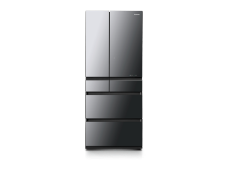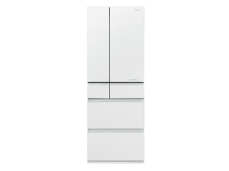
Keep Food Hygienic Everyday
How careful are you about food hygiene in your daily life?
Food poisoning doesn’t just happen in restaurants and food stalls, but also in everyday life at home.
Let's reduce the risk of food poisoning at home and maintain food safely by managing our food storage methods.

Inhibits bacteria floating inside the refrigerator and on refrigerator surfaces. Also effective for deodorising unpleasant odour.

Eliminates bacteria where meat and fish are stored to preserve them in good condition.

Removes unpleasant smells and annoying food odours. Also effective in deactivating bacteria.
5 keys for a hygienic food life
1. Buy food in good condition
The first step in safe home food storage is to choose food in good condition. Be sure to check the expiration date. Also, check the packages whether they are torn or damaged, since bacteria may enter from those spaces. The last important point is to keep in mind whether the grocery store itself is clean.
Handling delivered food
Be especially careful when ordering prepared food for delivery, because it takes time after it is cooked until it reaches your table. All prepared food delivery companies are obliged to have a food safety management system. Be sure to choose a licensed vendor and check the cooking time and expiration date labels on the product when it arrives. In households with small children or elders, it is best to avoid delivered food items.
Be careful not to buy too much!
When you buy food, think about how much you need. If you buy more than you can eat, it will spoil and lead to food waste. Only buy fresh food at a reliable shop that can be consumed by the expiration date. That is an important step in hygienic food management.
(From the Singapore Environment Agency website)
https://www.nea.gov.sg/media/news/news/index/nea-and-ava-remind-food-operators-to-remainvigilant-and-ensure-good-food-hygiene-practices-during-the-upcoming-festive-season


2. Store food as soon as you buy it to keep it at the right temperature
Always store fresh food in the refrigerator immediately. If you detour on your way home, your food may deteriorate in the meantime. Go straight home, especially if the outdoor temperature is high. If you can't go home right away, or when you want to buy fresh items, it helps to bring a cooling bag.
>Learn about Panasonic’s nanoe™X, which is ideal for combating bacteria

What is the proper temperature for refrigerator interiors?
It is very important to have the right temperature when you are storing food. Many harmful bacteria grow within the range of 20 to 45˚C. Below 10˚C, most stop breeding; they enter dormancy at 0˚C. Therefore, the ideal temperature inside the refrigerator is 4˚C or lower. Keep the freezer at -18˚C or lower. 0 to -3˚C is called the “ideal freezing range”.
When storing breast milk
Breast milk can actually be stored for about 4 hours at room temperature, if it is 25˚C or lower. However, if you want to store it longer, put it in a refrigerator set to 5˚C or lower. Even in those conditions, it is recommended to serve it in about 2 days.
3. Wash your hands diligently using the correct method
Do you really wash your hands the right way? Wash them for at least 20 seconds using soap and water for proper results. 99% of the bacteria on your hands can be removed by thoroughly washing the palms, between the fingers, the backs of your hands and under your nails. Don’t forget your wrists.
Be sure to wash your hands before handling food
Wash your hands when you return home from shopping and before you start cooking. But that’s not all! For example, after you handle fresh fish, be sure to wash your hands before you cook, to reduce the chance that bacteria will be transferred from food to food. If you get recipes from your smartphone or tablet, be careful! They are not so clean as you think.
Be sure to wash food and cooking utensils properly!
Bacteria may remain between the leaves of leafy vegetables, so rinse them well with water. When fresh meat is cut, bacteria can be transferred from the meat to other food. If you don’t wash the cutting board or knife and then cut vegetables, food poisoning could occur. Use different utensils for fresh food and for other food.
(From the Singapore Food Agency website)
https://www.sfa.gov.sg/food-retail/food-hygiene-practices-guidelines/food-hygiene-practices-guidelines


4. Heat food thoroughly before eating it.
Even if a meat is fresh, it may present some risks. Viruses and bacteria are killed when they are heated well. Therefore, it is important to heat meat thoroughly while cooking to prevent illness.
Keep the interior heat at 75˚C for at least 1 minute.
When cooking a large piece of meat, finish it by maintaining the temperature at 75˚C for 1 minute in the center, measured with a meat thermometer. Bacteria will mostly be attached to the surface of a solid piece of meat, so it may seem that there is no problem if the surface is well cooked. But when you cook minced meat to make meatballs or hamburgers, please heat each item to the center. When the center of the meat has changed from pink to brown and the juice is fairly clear, it is probably well-cooked throughout. Many of the dangerous bacteria, such as salmonella, enterobacteria, and campylobacter, are killed this way.
Dealing with leftovers
Even if you're refrigerating cooked food, be sure to reheat it before you eat.
Curry and soup cooked in a pot become hypoxic when heated. If it is left at room temperature overnight, Clostridium perfringens, which survives without oxygen and can grow and cause illness.
(From Japan Government Public Relations Online) https://www.gov-online.go.jp/featured/201106_02/index.html
>Learn about the Blue Ag hygiene function, which preserves the delicious qualities of meat and fish safely.

5. Immediately put leftovers in the fridge
“Can I leave leftover dishes, side dishes, excess fried noodles, etc. on the table if I wrap or cover them?” The answer is "No". Leaving them at room temperature is a great way to encourage bacteria!
Store them in the fridge as soon as the meal is over. If leftovers are stored correctly, you can safely consume them later. You don’t have to throw them out.
Always keep the inside of the fridge clean
Bacteria is not visible and can grow in the fridge without your awareness. Keeping the refrigerator clean is very important. When an area gets dirty, clean it quickly with a damp towel before it hardens. If something is difficult to remove, put a little dish detergent and water on a towel.
>Learn about Panasonic’s Ag Clean, which is ideal for neutralising bacteria in the refrigerator


Panasonic Original Hygiene Technology
Handle food more safely with Panasonic technology
Panasonic has been working hard to develop refrigerators that are not only easy to use but also safe. Using these technologies painstakingly developed over many years, you can store food more safely to keep raw food to already-cooked side dishes delicious for longer.
We contribute to healthy and enjoyable food experience for you, in your own home.

Top level food protection with the power of ions
“nanoe™X” refers to ions generated by applying high voltage to moisture in the air.
Various effects have been scientifically demonstrated, such as removing airborne bacteria from the refrigerator, bacteria adhering in the refrigerator’s interior walls, pesticides adhering to food, and refrigerator odours. These ions, generating within the refrigerator, keep the inside of the refrigerator clean in every nook and cranny.

Sterilisation is maximised by the use of blue LEDs.
By combining highly antibacterial silver ions with blue LEDs, the "Blue Ag" produces a large amount of hydroxyl radicals that suppress bacteria. Since it can do away with 99.99% of bacteria, it is safe to refrigerate raw fish and meat.



Keep the air inside the refrigerator clean
The Ag filter, installed inside the refrigerator, thoroughly purifies the cold air throughout the entire refrigerator. It does away with 99.9% of the bacteria that may cause food to deteriorate in quality. It also removes substances that cause odours and exerts deodorising effect.

Related Articles

Clean every corner of the refrigerator with fine particle ions
“nanoe™X” are nano-sized ions that perform both sterilisation and deodorisation.

Keeps meat and fish delicious and hygienic with Blue Ag
Contains bacteria growth by combining the antibacterial effects of silver ions with blue LED light.

Keep the air always clean in the refrigerator
A special filter with silver ions that provides hygienic air and penetrates the refrigerator.















